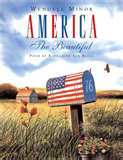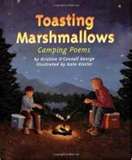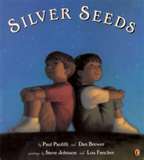America the Beautiful
 When I see the words “O beautiful for spacious skies”, I automatically sing in my head “for amber waves of grain”, but I didn’t know some of the other verses of this song that, for me, are so moving:
When I see the words “O beautiful for spacious skies”, I automatically sing in my head “for amber waves of grain”, but I didn’t know some of the other verses of this song that, for me, are so moving:
“O beautiful for heroes proved
In liberating strife,
Who more than self their country loved,
And mercy more than life!”
Katherine Lee Bates wrote the patriotic poem America the Beautiful in 1893, and Wendell Minor illustrated the verses to make the perfect book to help us celebrate our Independence Day. An introduction at the beginning of the book gives a bit of history about the poem, but the rest of the book is filled with Minor’s gorgeous paintings that bring to life the words we’ve sung for over 100 years.
Before reading the book, sing the familiar first verse of the song with students. The imagery is lovely, but may be hard for young ones to envision. What do amber waves of grain look like? Or purple mountains above the fruited plain? Ask students to do a quick draw of what the song makes them picture in their minds. Then, read aloud a bit of the introduction where we learn that Katherine Lee Bates wrote this poem after traveling from Massachusetts to Colorado. As she traveled, she wrote in her diary about the amazing, diverse landscapes she saw in our big, beautiful country. Read/sing the book once straight through with your students without stopping to comment just for the enjoyment of the book. Then, go back and revisit how the artist interpreted the poet’s words.
Minor includes in the endnotes the settings for each of his paintings. On the map in the back of the book, show students where you might see those fruited plains, those purple-shadowed mountains. Bates wrote her poem back before Alaska and Hawaii were part of our country – what might she have said about those states in her poem? Talk about your state and what its natural features look like. Have students draw and write about the beautiful state they live in, and celebrate the America in which we are so lucky to live.
Read MoreMake Poetry Delicious with “Toasting Marshmallows”
 I’ve had the pleasure of teaching poetry lessons to more than 175 students this week, and one sure-fire hit book I shared was Toasting Marshmallows: Camping Poems written by Kristine O’Connell George and illustrated by Kate Kiesler. Before I shared the title poem with the students, I told them how eager I am to go camping this summer. Amidst waving hands and shouts of “Me, too!” I talked about my memories of campfires – the smoky smell of burning wood, the welcome warmth after the sun goes down, and, of course, the requisite toasting of the marshmallows. I read aloud Kristine George’s poem in which we hear about two kinds of marshmallow toasters – those who like to patiently roast the marshmallow until the “pillowed confection” becomes “golden perfection” and those who shove ’em on a stick, burn ’em, flick off the soot, and eat ’em, char and all. The only thing that could’ve made the kids more eager to get their hands on this book when I was done with the lesson would’ve been to bring in marshmallows and build a campfire on the playground (a librarian can dream, can’t she?)
I’ve had the pleasure of teaching poetry lessons to more than 175 students this week, and one sure-fire hit book I shared was Toasting Marshmallows: Camping Poems written by Kristine O’Connell George and illustrated by Kate Kiesler. Before I shared the title poem with the students, I told them how eager I am to go camping this summer. Amidst waving hands and shouts of “Me, too!” I talked about my memories of campfires – the smoky smell of burning wood, the welcome warmth after the sun goes down, and, of course, the requisite toasting of the marshmallows. I read aloud Kristine George’s poem in which we hear about two kinds of marshmallow toasters – those who like to patiently roast the marshmallow until the “pillowed confection” becomes “golden perfection” and those who shove ’em on a stick, burn ’em, flick off the soot, and eat ’em, char and all. The only thing that could’ve made the kids more eager to get their hands on this book when I was done with the lesson would’ve been to bring in marshmallows and build a campfire on the playground (a librarian can dream, can’t she?)
Kristine George has a teacher’s guide full of cool extension ideas for Toasting Marshmallows: Camping Poems on her website: www.kristinegeorge.com. I love the idea of bringing in flashlights to use while writing poems like the four haiku about flashlights George included in her book, or working with metaphor in a writing-skills lesson. George compares the flashlight beam in the dark to a round stepping stone. What else might a flashlight beam be like? Turn off the lights, turn on the flashlights, and let the brainstorming begin! After sharing this book of poetry with your kids, you’ll hear lots of “S’more! Read s’more!”
Read MoreUse Silver Seeds to plant poems
 This is one of my go-to books I use every April to celebrate Poetry Month. Silver Seeds by Paul Paolilli and Dan Brewer with paintings by Steve Johnson and Lou Fancher is simply beautiful. The poems are all about nature, and they’re all written in a form many kids recognize. When I show the first poem,
This is one of my go-to books I use every April to celebrate Poetry Month. Silver Seeds by Paul Paolilli and Dan Brewer with paintings by Steve Johnson and Lou Fancher is simply beautiful. The poems are all about nature, and they’re all written in a form many kids recognize. When I show the first poem,
“Down goes the moon
And up comes the sun,
Welcoming the
New Day”
lots of hands wave in the air, “It’s an acrostic!” Yes, these poems have a word as the topic of the poem written from top to bottom on the page, and each letter starts a line of the poem. When we teach our kids to begin writing poetry, it’s an easy form to follow. I love that the poems in this book aren’t just one word per letter, but you can show kids how to write acrostic poems using either one word to make a descriptive list, or several words per line to paint a broader picture.
Silver Seeds is a great poetry book to hit the Common Core State Standard of Range of Reading (RL. 10 if you’re keeping score) in the elementary grades, but it’s also a cool writing activity to get kids to use the dictionary. I model for the students how to write an acrostic poem about myself using my first name. I ask, “What could I put for K?” Krazy, Kool, Kitten, and Kid are usually suggested, but none of these really works for me. How can I find a K word that I think describes me? I open up the dictionary and begin to browse. Perhaps I am kaput (there are days when this is too accurate!), or keen, or kissable. I decide that I am Kindly, and we can go on to brainstorming and looking for R words. Using the dictionary to find words to describe themselves is a fun way to use the resource and you’ll be thrilled at some of the new adjectives your students learn. A love of language, a love of poetry, planted with Silver Seeds.
For more information, visit johnson&fancher.com
Read More






